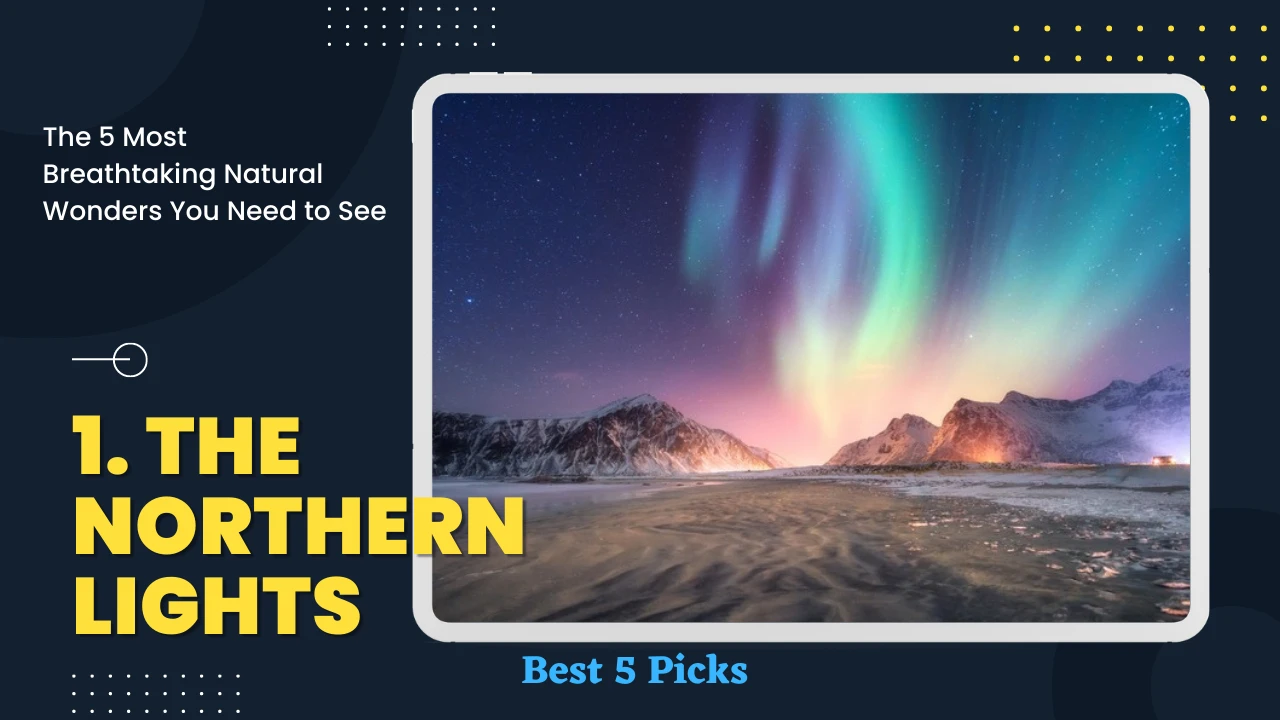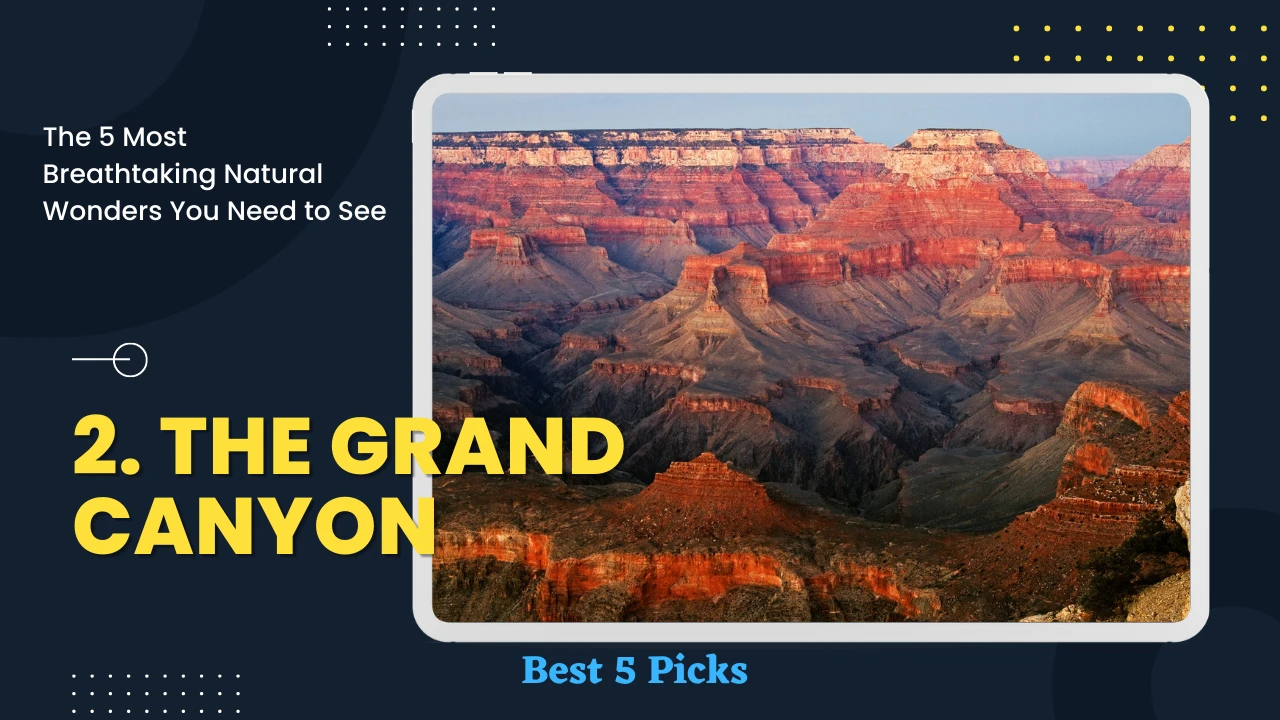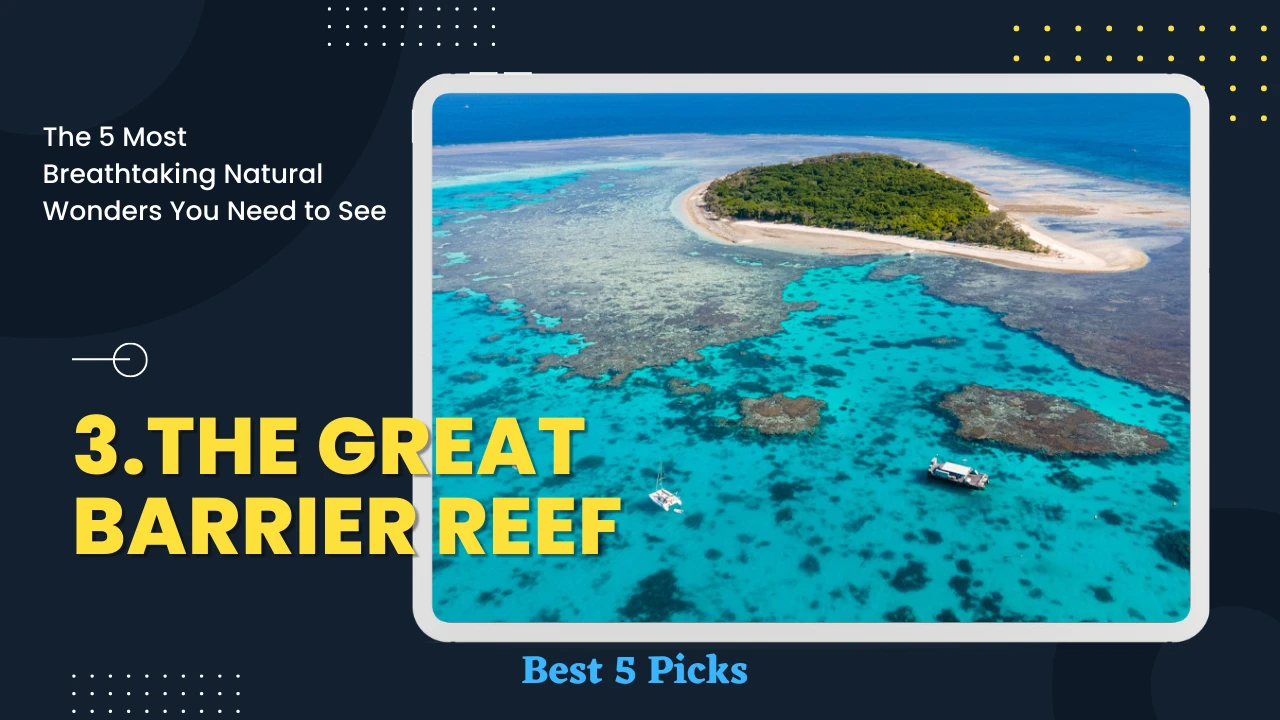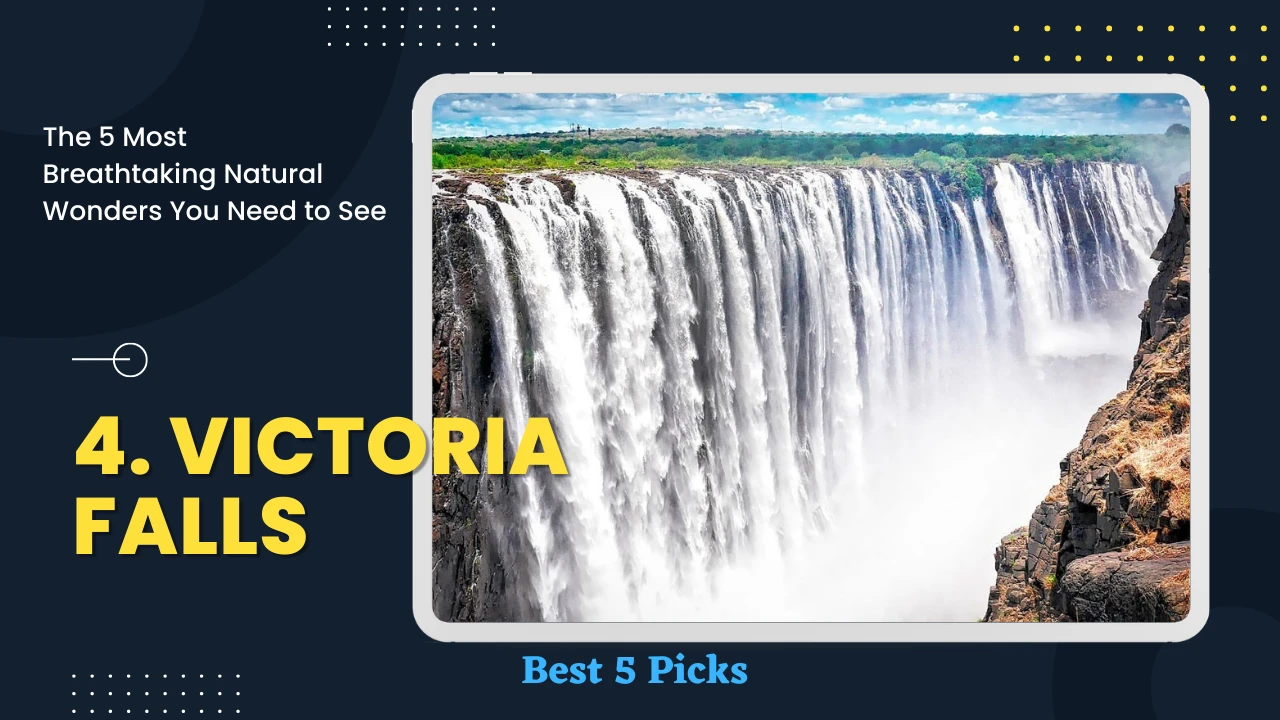Discover the awe-inspiring beauty of our planet with our guide to the “5 Most Breathtaking Natural Wonders You Need to See.”
Immerse yourself in the wonders of nature as we take you on a journey to some of the most stunning and captivating landscapes the world has to offer.
From majestic waterfalls to towering mountain ranges, this article showcases the Earth’s most breathtaking natural marvels that will leave you in awe of the sheer magnificence of our planet.
Embark on a virtual tour through the mesmerizing images and captivating descriptions of these extraordinary natural wonders.
Are You In Hurry? Then Check Out Below!
Whether you’re a passionate traveler or an armchair explorer, this compilation will inspire your sense of wanderlust and ignite a deep appreciation for the diverse and awe-inspiring beauty that Mother Nature has sculpted over centuries.
Don’t miss the opportunity to add these must-see destinations to your bucket list and experience firsthand the magic of the 5 Most Breathtaking Natural Wonders You Need to See.

Next Picks For You
I. Introduction
Welcome to our article on the “5 Most Breathtaking Natural Wonders You Need to See.” In this captivating exploration, we will take you on a journey to some of the most awe – inspiring natural wonders our planet has to offer.
From shimmering displays of the Northern Lights to the majestic depths of the Grand Canyon, we will unveil these magnificent destinations that will leave you in awe of nature’s beauty.
A. Capturing the essence of nature’s wonders
Embark on a journey into the heart of our planet’s most captivating landscapes with our exploration of the “5 Most Breathtaking Natural Wonders You Need to See.”
In this article, we delve into the extraordinary beauty that defines these natural marvels, capturing the very essence of their awe-inspiring presence.
From cascading waterfalls to towering mountain peaks, join us in unraveling the secrets held by these landscapes, as we strive to encapsulate the unparalleled magic that nature has crafted across the globe.
B. The transformative power of witnessing these breathtaking marvels
Experience the transformative power of immersing yourself in the presence of these breathtaking natural wonders.
Beyond the visual spectacle, these marvels possess a unique ability to inspire, leaving an indelible mark on those fortunate enough to witness their grandeur.
As we guide you through each wonder, reflect on the profound impact that such encounters can have, evoking a sense of wonder and appreciation for the world we call home.
Prepare to be moved by the transformative journey that awaits, as we explore the unparalleled beauty and significance of these awe-inspiring creations of nature.
C. Importance of experiencing natural wonders
In today’s fast-paced world, it’s easy to get caught up in our daily routines and forget about the extraordinary beauty that surrounds us.
However, taking the time to immerse ourselves in the marvels of nature is not only a rejuvenating experience but also an essential reminder of the grandeur and power of the world we inhabit.
Experiencing natural wonders offers a range of benefits for our physical and mental well-being. It allows us to escape the noise and distractions of modern life and reconnect with the natural world.
It can be a source of inspiration, igniting our curiosity and creativity. Being in the presence of these wonders can evoke a sense of humility and remind us of our place in the larger tapestry of life.
Furthermore, witnessing natural wonders can be a transformative experience. It can broaden our perspective, deepen our appreciation for the planet, and instill a desire to protect and conserve these fragile environments for future generations.
By embarking on a journey to these breathtaking natural wonders, we have the opportunity to marvel at the extraordinary forces that have shaped our planet over millions of years.
Whether it’s the dancing lights of the Aurora Borealis or the raw power of Victoria Falls, these wonders possess a unique ability to captivate and inspire us.
So, join us as we embark on this extraordinary adventure and discover the five natural wonders that will leave an indelible mark on your soul.
From the vivid colors of the Northern Lights to the vibrant biodiversity of the Amazon Rainforest, these awe-inspiring destinations will remind you of the immense beauty and wonder that exists in the world around us.
II. The 5 Most Breathtaking Natural Wonders You Need to See
Discover the Top 5 Breathtaking Natural Wonders You Must See! From the mesmerizing Northern Lights to the awe-inspiring Grand Canyon, this article unveils the most captivating natural wonders that will leave you in awe.
Dive into the stunning Great Barrier Reef, marvel at the power of Victoria Falls, and immerse yourself in the biodiversity of the Amazon Rainforest.
Get inspired and plan your next adventure to witness these incredible wonders firsthand. Read now and start your journey to natural beauty!
1. The Northern Lights

1.1 Description of the Northern Lights phenomenon
The Northern Lights, also known as the Aurora Borealis, is a captivating natural phenomenon that illuminates the night sky with vibrant colors.
It occurs when charged particles from the sun collide with atoms and molecules in the Earth’s atmosphere, causing them to emit light.
The most common colors observed are green and pink, but shades of red, yellow, blue, and purple can also be seen.
The Northern Lights are often described as dancing curtains of light, swirling and shifting across the horizon.
This mesmerizing display creates a magical atmosphere and leaves spectators in awe of nature’s beauty.
1.2 Best places to witness the Northern Lights
1. Tromsø, Norway: Located within the Arctic Circle, Tromsø offers excellent viewing opportunities due to its favorable position under the auroral oval.
The city’s relatively mild climate and clear winter nights make it an ideal destination for experiencing the Northern Lights.
2. Fairbanks, Alaska: Situated in the heart of Alaska, Fairbanks provides a prime location for viewing the Aurora Borealis.
Its northern latitude and cold, dry climate contribute to frequent sightings. Visitors can also explore nearby wilderness areas and partake in various winter activities.
3. Reykjavik, Iceland: With its dark skies, minimal light pollution, and accessible landscapes, Reykjavik is a popular destination for witnessing the Northern Lights.
The country’s geothermal hot springs and stunning volcanic landscapes add to the allure of the experience.
4. Abisko, Sweden: Nestled in the Swedish Lapland, Abisko is renowned for its clear skies and high chances of seeing the Northern Lights.
The Abisko National Park offers picturesque settings and dedicated viewing platforms for an unforgettable encounter with this natural wonder.
5. Yellowknife, Canada: As the capital of Canada’s Northwest Territories, Yellowknife is well-known for its prime Northern Lights viewing opportunities.
Its northern location, vast wilderness, and freezing temperatures provide an ideal setting for witnessing the celestial spectacle.
1.3 Tips for optimal viewing experience
Choose the right time: The Northern Lights are more visible during the winter months when the nights are longer and darker.
Plan your trip between September and March for the best chances of witnessing this phenomenon.
Check the forecast: Monitor aurora forecasts and space weather reports to determine the most favorable conditions for viewing.
Websites and smartphone apps dedicated to aurora forecasts can help you stay updated on potential sightings.
Find dark and clear skies: Minimize light pollution by venturing away from cities and finding remote locations with minimal artificial light.
Clear skies are essential, so check weather conditions and opt for nights with limited cloud cover.
Be patient: Seeing the Northern Lights is a natural phenomenon, and sightings are not guaranteed.
It requires patience and persistence, as the lights may appear and disappear unexpectedly. Stay out for several hours to increase your chances of witnessing the full display.
Capture the moment: Bring a camera capable of long-exposure photography to capture the Northern Lights’ beauty.
Learn about night photography techniques and experiment with different settings to document this breathtaking spectacle.
By following these tips and choosing the right location, you can enhance your chances of witnessing the awe-inspiring Northern Lights and create unforgettable memories of this natural wonder.
So our “The 5 Most Breathtaking Natural Wonders You Need to See” journey next Natural Wonder are The Grand Canyon.
2. The Grand Canyon

2.1 Overview of the Grand Canyon’s Geological Features
- Introduction to the Grand Canyon’s formation through erosion and geological processes
- Description of its massive size and depth
- Explanation of the distinct layers of rock formations visible in the canyon walls, showcasing millions of years of Earth’s history
- Mention of the Colorado River, which carved the canyon over millions of years
2.2 Activities and Viewpoints within the Grand Canyon
– Hiking: Highlighting popular hiking trails such as the Bright Angel Trail, South Kaibab Trail, and Rim-to-Rim Trail
– Rafting: Mentioning the exhilarating experience of whitewater rafting through the canyon’s rapids
– Scenic Drives: Recommending scenic drives along Desert View Drive and Hermit Road, offering breathtaking views from various overlooks
– Mule Rides: Discussing the unique opportunity to explore the canyon on muleback, including trips to the bottom of the canyon
– Helicopter Tours: Suggesting helicopter tours for a bird’s-eye view of the canyon’s immense scale and beauty
– Camping and Overnight Stays: Mentioning the availability of campgrounds and lodges within the national park for extended visits
2.3 How to Plan a Trip to the Grand Canyon
1. Choosing the Right Time to Visit:
- Discussing the different seasons and their impact on weather, crowds, and accessibility
- Suggesting spring and fall as popular times for pleasant weather and fewer crowds
2. Selecting the Entry Point:
- Providing information about the South Rim and the North Rim as the main entry points
- Comparing the differences in scenery and visitor facilities between the two rims
3. Transportation:
- Mentioning the availability of shuttle buses within the park to facilitate movement between viewpoints and trailheads
- Providing information about nearby airports and transportation options for visitors flying in
4. Accommodation Options:
- Discussing the various lodging options within the park, including lodges, cabins, and campgrounds
- Mentioning the need for early reservations, especially during peak seasons
5. Safety and Preparation:
- Emphasizing the importance of carrying essential supplies like water, sunscreen, and appropriate clothing for the desert environment
- Advising visitors to check weather conditions and trail status before embarking on hikes or other outdoor activities
- Mentioning the availability of guided tours and park ranger programs for additional guidance and safety information
6. Additional Considerations:
- Discussing the entrance fees and park passes required for visiting the Grand Canyon
- Encouraging visitors to respect the park’s rules and regulations, including responsible waste disposal and wildlife preservation
By following these guidelines and taking advantage of the various activities and viewpoints within the Grand Canyon, visitors can fully immerse themselves in the awe-inspiring beauty and geological wonders of this natural wonder.
So our “The 5 Most Breathtaking Natural Wonders You Need to See” journey next Natural Wonder are The Great Barrier Reef.
3. The Great Barrier Reef

3.1 Introduction to the Great Barrier Reef ecosystem
The Great Barrier Reef, located off the coast of Queensland, Australia, is the world’s largest coral reef system.
Spanning over 2,300 kilometers (1,400 miles) and composed of nearly 3,000 individual reefs, it is a breathtaking natural wonder that attracts visitors from all around the globe.
The Great Barrier Reef ecosystem is home to an incredible diversity of marine life, including more than 1,500 species of fish, 600 types of coral, and numerous other unique creatures such as turtles, dolphins, and whales.
The vibrant and colorful coral formations provide a mesmerizing backdrop to the crystal-clear waters, making it a paradise for snorkelers and divers.
3.2 Snorkeling and diving opportunities
Snorkeling and diving in the Great Barrier Reef offer unparalleled experiences to explore the underwater world.
Whether you are a beginner or an experienced diver, there are options available for everyone.
Snorkeling is a popular activity for those who want to observe the reef from the surface. With a mask, snorkel, and fins, you can glide over the shallow reefs and encounter a kaleidoscope of marine life.
Many tour operators offer guided snorkeling trips, providing safety instructions and knowledgeable guides to enhance the experience.
For those seeking a more immersive adventure, scuba diving is the ideal choice.
With dive sites ranging from easy to advanced, divers can explore the vibrant coral gardens, swim alongside tropical fish, and even encounter larger marine species like manta rays and reef sharks.
Certified divers can choose from various dive operators that offer single or multi-day trips, with options for both beginners and experienced divers.
3.3 Conservation efforts and challenges
The Great Barrier Reef faces significant conservation challenges due to climate change, pollution, and other human activities.
The main threat to the reef’s health is coral bleaching, caused by rising sea temperatures.
Bleaching occurs when corals expel their symbiotic algae, resulting in their vibrant colors fading and leaving them vulnerable to disease and death.
Numerous conservation efforts are underway to protect and preserve the Great Barrier Reef.
Australia’s government, along with research institutions and environmental organizations, is implementing strategies to reduce pollution, regulate fishing practices, and promote sustainable tourism.
These initiatives aim to mitigate the impacts of climate change, improve water quality, and restore damaged sections of the reef.
Visitors to the Great Barrier Reef can contribute to conservation efforts by choosing eco-friendly tour operators, practicing responsible snorkeling and diving techniques, and respecting the delicate ecosystem.
It is crucial to follow guidelines such as not touching or damaging the coral, properly disposing of waste, and using reef-safe sunscreen to minimize harm to the reef and its inhabitants.
By raising awareness about the importance of conservation and supporting sustainable practices, we can help ensure the long-term survival of this magnificent natural wonder, allowing future generations to marvel at the wonders of the Great Barrier Reef.
So our “The 5 Most Breathtaking Natural Wonders You Need to See” journey next Natural Wonder are Victoria Falls.
4. Victoria Falls

4.1 Description of Victoria Falls’ Impressive Size and Power
Victoria Falls, located on the Zambezi River at the border of Zambia and Zimbabwe, is one of the most awe-inspiring natural wonders in the world.
Known locally as “Mosi-oa-Tunya” meaning “The Smoke that Thunders,” Victoria Falls lives up to its name with its breathtaking size and power.
It is considered the largest waterfall globally, both in terms of its width and height.
With a width of about 1.7 kilometers (1 mile) and a height of approximately 108 meters (355 feet), the falls create a mesmerizing spectacle of cascading water that is truly unforgettable.
The sheer force of the water plunging into the gorge below creates a continuous spray that rises like mist, forming a dense cloud of mist and spray that can be seen from miles away.
4.2 Activities and Attractions near Victoria Falls
In addition to the magnificent waterfall itself, there are numerous activities and attractions that make a visit to Victoria Falls an unforgettable experience.
One popular activity is taking a guided tour of the falls, where visitors can witness the power and beauty up close.
The guided tours provide insightful information about the geology, flora, and fauna surrounding the falls, enriching the overall experience.
For adventure enthusiasts, Victoria Falls offers an array of thrilling activities.
One such activity is white-water rafting on the Zambezi River, where you can navigate the rapids and experience the adrenaline rush.
Another popular adventure is bungee jumping off the Victoria Falls Bridge, which provides a heart-stopping freefall experience with the falls as a dramatic backdrop.
For a more relaxed experience, visitors can enjoy sunset cruises along the Zambezi River, offering breathtaking views of the falls and the surrounding wildlife.
Wildlife enthusiasts can also explore the nearby national parks, such as Mosi-oa-Tunya National Park, where they can embark on game drives and spot a variety of animals, including elephants, giraffes, zebras, and various bird species.
4.3 Best Time to Visit and Practical Considerations
The best time to visit Victoria Falls largely depends on personal preferences and the experience one seeks.
However, the falls are most spectacular during the wet season, which occurs from November to April.
During this period, the Zambezi River swells, and the falls reach their maximum flow, creating a thunderous display of water.
The downside of visiting during the wet season is that the mist and spray can be so dense that it may obstruct views of the falls.
For those who prefer a clearer view, the dry season from May to October is ideal.
The water levels recede, revealing more of the underlying rock formations and allowing for better visibility. However, the volume of water may be reduced compared to the wet season.
When planning a visit to Victoria Falls, it is important to consider practical considerations.
Both Zambia and Zimbabwe offer entry points to view the falls, with Victoria Falls Town in Zimbabwe and Livingstone in Zambia serving as popular bases for exploring the area.
It is advisable to check visa requirements and plan accordingly, as they may vary depending on your nationality.
Additionally, it is essential to pack appropriate clothing, including a raincoat or waterproof gear to protect against the mist and spray from the falls.
Comfortable shoes are recommended for exploring the walking trails around the falls, as well as insect repellent for protection against mosquitoes.
By considering these factors and timing your visit accordingly, you can fully immerse yourself in the majesty of Victoria Falls and create unforgettable memories of this natural wonder.
So our “The 5 Most Breathtaking Natural Wonders You Need to See” journey next Natural Wonder are The Amazon Rainforest.
5. The Amazon Rainforest

5.1 Overview of the Amazon Rainforest’s Biodiversity
The Amazon Rainforest, often referred to as the “Lungs of the Earth,” is an unparalleled natural wonder known for its extraordinary biodiversity.
Spanning across several South American countries, including Brazil, Peru, Colombia, and Ecuador, the Amazon Rainforest boasts an intricate web of ecosystems that support a staggering array of plant and animal species.
The Amazon Rainforest is a biodiversity hotspot, housing an estimated 400 billion individual trees and over 16,000 species of amphibians, birds, mammals, and reptiles.
It is home to iconic creatures like jaguars, sloths, pink river dolphins, and vibrant bird species such as macaws and toucans.
Additionally, the rainforest harbors an astonishing variety of plant life, including medicinal plants, orchids, and towering trees that form a dense canopy.
5.2 Exploration Options and Wildlife Encounters
Visiting the Amazon Rainforest offers unparalleled opportunities for exploration and wildlife encounters.
Various options exist for experiencing the richness of this natural wonder, ensuring a memorable and immersive adventure.
1. Jungle Trekking
Embarking on a guided jungle trek is a popular way to explore the Amazon Rainforest.
Accompanied by experienced guides, visitors can hike through lush trails, discovering hidden waterfalls, secluded lagoons, and encountering diverse flora and fauna along the way.
This type of exploration allows visitors to appreciate the rainforest’s serenity and observe its inhabitants up close.
2. River Cruises
River cruises offer a unique perspective of the Amazon Rainforest, allowing visitors to navigate its winding waterways and tributaries.
Cruises provide a comfortable and leisurely way to explore the rainforest’s remote regions, passing through dense foliage and observing wildlife from the comfort of a boat.
This option often includes guided excursions to spot animals like monkeys, caimans, and colorful birds.
3. Canopy Walks
Canopy walks provide an exhilarating experience by taking visitors above the forest floor and into the treetops.
Suspended walkways and observation platforms allow for a bird’s-eye view of the rainforest, offering a chance to spot rare species and observe the bustling canopy ecosystem.
This unique perspective provides insights into the interdependence of plants, animals, and insects within the rainforest.
5.3 Sustainability and Preservation of the Rainforest
The Amazon Rainforest faces numerous threats, including deforestation, illegal logging, and habitat destruction.
It is crucial to prioritize sustainability and preservation efforts to protect this invaluable natural wonder for future generations.
1. Conservation Initiatives
Several organizations and initiatives are dedicated to conserving the Amazon Rainforest and its biodiversity.
These efforts focus on combating deforestation, promoting sustainable land use practices, and supporting local communities.
Initiatives may include reforestation projects, sustainable agriculture programs, and advocacy for indigenous rights.
2. Responsible Tourism
Engaging in responsible tourism practices is essential when visiting the Amazon Rainforest.
This includes choosing eco-friendly accommodations, supporting local communities and indigenous tribes, and following guidelines to minimize environmental impact.
Visitors can also contribute to conservation efforts by supporting local sustainable businesses and participating in educational programs that raise awareness about rainforest preservation.
3. Advocacy and Awareness
Raising awareness about the importance of the Amazon Rainforest and its biodiversity is crucial for its long-term preservation.
By spreading knowledge about the rainforest’s ecological significance and the threats it faces, individuals can contribute to conservation efforts.
Supporting organizations that work towards rainforest protection and engaging in advocacy initiatives can help safeguard this natural wonder.
III. Conclusion
In this article, we have explored five of the most breathtaking natural wonders that you absolutely need to see.

5 Most Breathtaking Natural Wonders You Need to See
- The Northern Lights
- The Grand Canyon
- The Great Barrier Reef
- The Victoria Falls
- The Amazon Rainforest
From the enchanting Northern Lights to the awe-inspiring Grand Canyon, the vibrant Great Barrier Reef, the majestic Victoria Falls, and the mesmerizing Amazon Rainforest, these natural wonders offer unparalleled beauty and experiences.
Each wonder possesses its unique characteristics, attracting adventurers and nature enthusiasts from around the world.
A. Encouragement to Experience These Wonders Firsthand
If you haven’t already, it is highly encouraged to plan a trip to witness these natural wonders firsthand.
The descriptions and photographs provided in this article can only capture a fraction of the true magnificence these places hold.
To truly grasp their grandeur, you need to immerse yourself in the sights, sounds, and sensations that only being present can provide.
Whether you’re standing in awe as the Northern Lights dance across the night sky, peering into the vastness of the Grand Canyon, snorkeling amidst the vibrant marine life of the Great Barrier Reef, feeling the mist of Victoria Falls on your face, or exploring the lush depths of the Amazon Rainforest, these experiences are bound to leave an indelible mark on your soul.
B. Closing Thoughts and Inspiration for Future Adventures
As you reflect on the beauty and wonder of these natural phenomena, remember that there is a whole world of breathtaking destinations waiting to be discovered.
Nature has an endless array of marvels, and embarking on these adventures not only enriches your life but also fosters a deeper appreciation for the planet we call home.
Consider this article as a starting point for your future adventures. Let it inspire you to seek out other natural wonders, to embrace the unknown, and to immerse yourself in the extraordinary.
Whether you’re scaling mountains, diving into crystal-clear waters, traversing vast forests, or witnessing otherworldly phenomena, remember that the world is yours to explore.
So pack your bags, gather your sense of adventure, and set out to witness the beauty that nature has to offer. Let these natural wonders be a reminder of the incredible diversity and splendor of our planet.
May they serve as a call to protect and preserve these treasures for generations to come. Adventure awaits, and the wonders of the world are waiting to be explored by you.
In conclusion, don’t miss out on the chance to witness these breathtaking natural wonders firsthand.
From the captivating Northern Lights to the awe-inspiring Grand Canyon, the wonders of the Great Barrier Reef, the majestic Victoria Falls, and the vibrant Amazon Rainforest, there is a world of beauty waiting to be explored.
Plan your trips, immerse yourself in nature’s wonders, and create memories that will last a lifetime. Start your adventure today!
IV. Frequently Asked Questions (FAQ)
What causes the Northern Lights, and where is the best place to see them?
The Northern Lights, or Aurora Borealis, are caused by solar wind interacting with Earth’s atmosphere. The best places to witness this phenomenon include Norway and other high-latitude regions.
Can you provide tips for photographing the Northern Lights?
To capture the beauty of the Northern Lights, use a sturdy tripod, a wide-angle lens, and a high ISO setting. Additionally, shoot in RAW format for better post-processing flexibility.
How deep is the Grand Canyon, and what are the must-visit spots?
The Grand Canyon’s depth varies, but it reaches over a mile (1.6 km) deep. Must-visit spots include the South Rim’s Grand Canyon Village and the North Rim’s Point Imperial.
What makes the Great Barrier Reef unique, and how can I contribute to its conservation?
The Great Barrier Reef is unique due to its vast coral formations and diverse marine life. To contribute to its conservation, choose eco-friendly tourism options, reduce your carbon footprint, and support organizations dedicated to reef preservation.
Are there adventure activities available at Victoria Falls?
Yes, Victoria Falls offers thrilling activities such as bungee jumping, white-water rafting, and helicopter tours. Devil’s Pool, on the edge of the falls, provides a unique and exhilarating experience.
Why is the Amazon Rainforest important for global ecology, and how can I explore it responsibly?
The Amazon Rainforest is crucial for maintaining biodiversity and regulating the Earth’s climate. Explore it responsibly by choosing eco-friendly tours, supporting sustainable practices, and respecting local communities.
Are there safety concerns when visiting these natural wonders?
While these wonders offer breathtaking experiences, it’s essential to prioritize safety. Follow guidelines, be aware of weather conditions, and choose reputable tour operators for a secure and enjoyable visit.
Can I combine visits to multiple natural wonders in one trip?
Depending on your travel plans and preferences, it’s possible to combine visits to some of these wonders. Consider factors like travel time, logistics, and the best seasons for each destination.
How can I contribute to the conservation of these natural wonders?
Support conservation efforts by donating to reputable organizations, practicing responsible tourism, and raising awareness about the importance of preserving these wonders for future generations.
Are there any specific travel restrictions or permits required for these destinations?
Check with relevant authorities for any travel restrictions or permits required for these destinations. Some natural wonders may have specific regulations to protect the environment and ensure a sustainable visitor experience.







